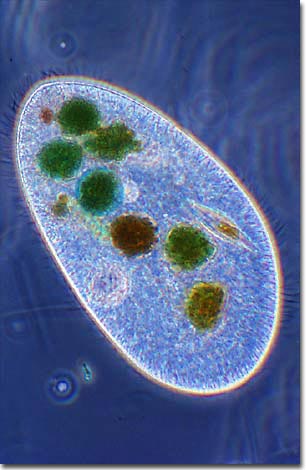Phase Contrast Image Gallery
Paramecium
The photomicrograph below illustrates a living paramecium rescued from a fresh pond in Tallahassee, Florida and captured on film with phase contrast optics. These creatures are among the most complex single-celled organisms found in fresh water.

Paramecium are protozoans that are shaped like a bedroom slipper, and which swim rapidly in a corkscrew fashion by means of an army of cilia that operate in wavelike movements. These tiny creatures are abundant in fresh water ponds, especially in areas that are rich in algae and other associated "pond scum". Like other protozoans and bacteria, paramecium reproduce several times a day by either binary fission (division into two daughter cells) or by conjugation where DNA is exchanged between two adjacent cells.
Over 75,000 individual species of paramecium have been recorded, and almost all have common complex internal features that make these microorganisms unique. As illustrated above, the surface of the paramecium is covered with hundreds of tiny hair-like projections called cilia, which are used to propel the organism through its aqueous environment. Visible structures inside the cytoplasm include a small and large nucleus (termed micro- and macronucleus, respectively), food vacuoles, a gullet-oral groove combination, and contractile vacuoles.
The paramecium swims by rotating along its longer axis and is constantly in search of food, which is swept into the organism by a series of cilia that line the oral groove and gullet. Most meals consist of bacteria and other small organisms, including smaller protozoans, that co-exist in the fresh water home of the paramecium.
BACK TO THE PHASE CONTRAST GALLERY
